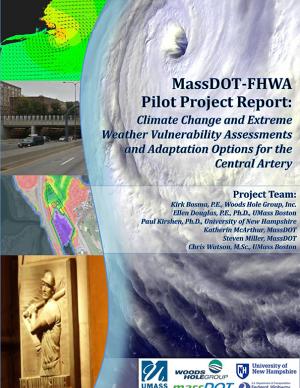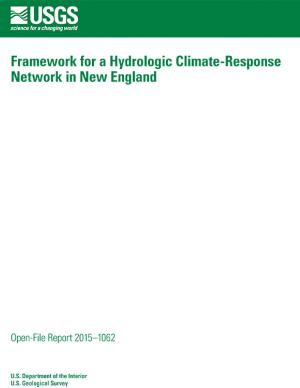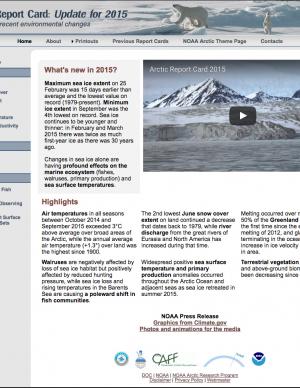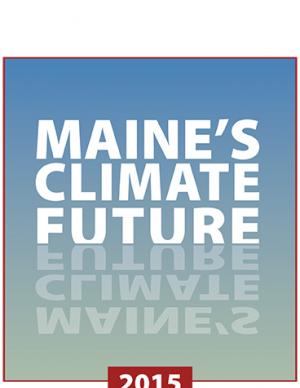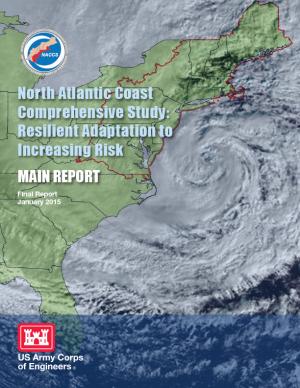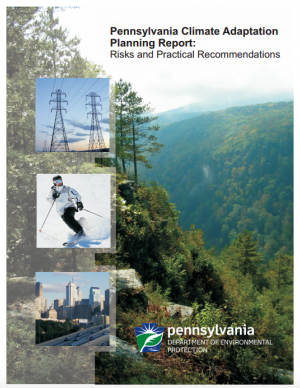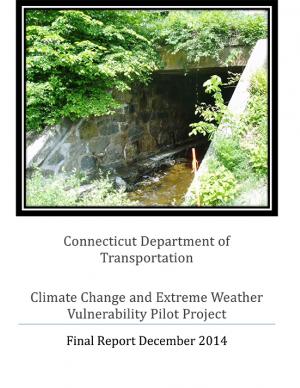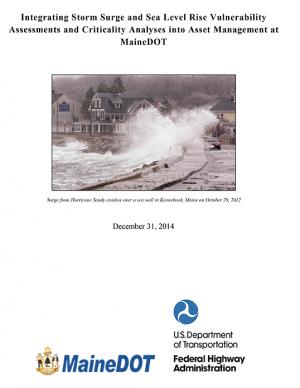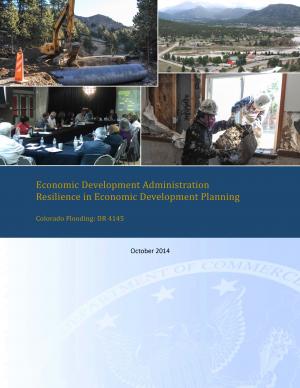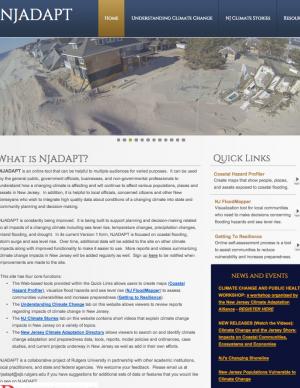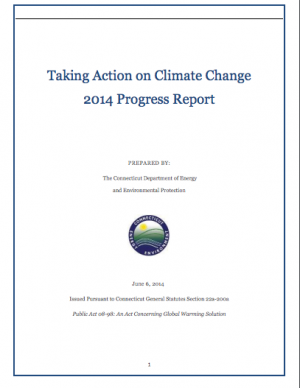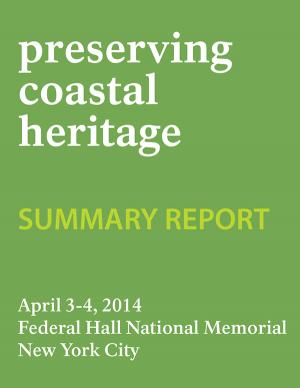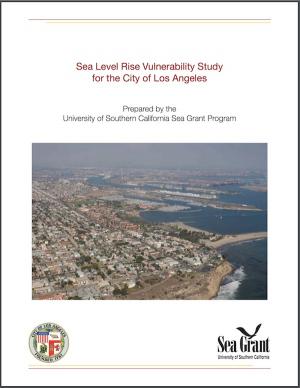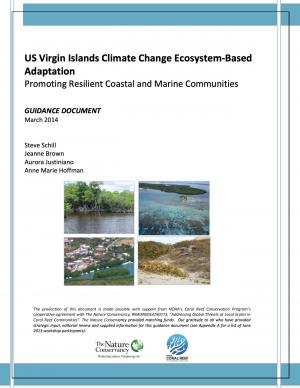Access a range of climate-related reports issued by government agencies and scientific organizations. Browse the reports listed below, or filter by scope, content, or focus in the boxes above. To expand your results, click the Clear Filters link.
The two main objectives of this pilot project were to (1) assess the vulnerability of Boston's Central Artery/Tunnel System to sea level rise and extreme storm events, and (2) investigate and present adaptation options to reduce identified vulnerabilities.
Many climate-related hydrologic variables in New England have changed in the past century, and many are expected to change during the next century. It is important to understand and monitor these changes because they can affect human water supply, hydroelectric power generation, transportation infrastructure, and stream and riparian ecology. This report describes a framework for hydrologic monitoring in New England by means of a climate-response network.
This report—the first phase of the Department of the Interior (DOI) assessment effort for Hurricane Sandy projects—was developed for DOI by a metrics expert group of physical and ecological scientists and socioeconomic experts who recommended performance metrics for measuring changes in resilience resulting from the DOI-sponsored projects. It identifies natural and artificial coastal features most affected by Hurricane Sandy along the Northeast coast—such as marshes, beaches, and estuaries—and recommended metrics that would indicate resilience change in those features.
This "report card" has been issued annually since 2006, and is a timely and peer-reviewed source for clear, reliable, and concise environmental information on the current state of different components of the Arctic environmental system relative to historical records. The information is intended for a wide audience, including scientists, teachers, students, decision makers, and the general public interested in the Arctic environment and science. Report Card 2015 contains 12 contributions prepared by an international team of 72 scientists from 11 different countries.
The State of New Hampshire has initiated a coordinated effort to proactively prepare for the effects of climate change on the natural and human resources of New Hampshire. An important aspect of this effort is to develop a vulnerability assessment of hydrologic response to climate change. The U.S. Geological Survey, in cooperation with the New Hampshire Department of Health and Human Services, is developing tools to predict how projected changes in temperature and precipitation will affect change in the hydrology of watersheds in the State. This study is a test case to assemble the information and create the tools to assess the hydrologic vulnerabilities in four specific watersheds.
Successfully negotiating climate change challenges will require integrating a sound scientific basis for climate preparedness into local planning, resource management, infrastructure, and public health, as well as introducing new strategies to reduce greenhouse gas emissions or increase carbon sequestration into nearly every sector of California’s economy. This Research Plan presents a strategy for developing the requisite knowledge through a targeted body of policy-relevant, California-specific research over three to five years (from early 2014), and determines California’s most critical climate-related research gaps.
This report builds on Maine’s earlier report from 2009—it is not intended as a comprehensive revision of all aspects of the original report. This update focuses on highlights of the understanding in 2015 of past, present, and future trends in key indicators of a changing climate specific to Maine, and recent examples of how Maine people are experiencing these changes.
The Resilient Strategies Guide for Water Utilities provides options for drinking water, wastewater, and stormwater utilities to assist them in developing plans that contain strategies that address their specific needs and priorities.
The Guide outlines the resilience planning process and helps you to identify potential strategies and promote a better understanding of resilience strategies. At the end of the Guide, you can download a report containing all of your selections and submitted information.
Find out how hometowns across the United States are building their resilience to climate change. Two women who studied climate change science and policy in graduate school took a three-month road trip to find out what climate change adaptation looks like in the United States. They visited more than 30 communities preparing for climate change and documented what they learned in blogs and through media reports. This report describes six big lessons from the ongoing adaptation work they saw across the country.
Western Water Assessment, in collaboration with the University of Colorado Boulder and Colorado State University, conducted a broad study of climate vulnerability for the state of Colorado. Drawing from existing data and peer-reviewed research, the study summarizes the key challenges facing seven sectors: ecosystems, water, agriculture, energy, transportation, outdoor recreation and tourism, and public health.
This report details the results of a two-year study to address coastal storm and flood risk to vulnerable populations, property, ecosystems, and infrastructure affected by Hurricane Sandy in the United States' North Atlantic region. The study was designed to help local communities better understand changing flood risks associated with climate change and to provide tools to help those communities better prepare for future flood risks. It builds on lessons learned from Hurricane Sandy and attempts to bring to bear the latest scientific information available for state, local, and tribal planners.
The American Planning Association's Hazards Planning Center worked with FEMA to develop Planning for Post-Disaster Recovery: Next Generation. This updated manual offers a no-nonsense explanation of the benefits and limitations of planning for unpredictable events.
According to this NOAA-sponsored study, natural oceanic and atmospheric patterns are the primary drivers behind California's ongoing drought.
This report provides current and relevant climate adaptation information to a diverse audience of legislators, government agencies, policy makers, educators, nongovernment organizations, business, industry, researchers, other stakeholders and the public.
In September of 2013, Governor Jack Markell of Delaware signed Executive Order 41 directing state agencies to address the causes and consequences of climate change. The order asked for recommendations to reduce greenhouse gas emissions, increase resilience to climate impacts, and find ways to avoid or minimize flood risks caused by rising sea level. The order also created a committee to oversee the development and implementation of recommendations.
This report presents the results of a Climate Resilience Pilot Project in which the Connecticut Department of Transportation conducted a systems-level vulnerability assessment of bridge and culvert structures six feet to 20 feet in length from inland flooding associated with extreme rainfall events. The vulnerability assessment of inland flooding was conducted because in recent years extreme precipitation events have been more frequent and intense, resulting in damage to infrastructure in several locations.
The Maine Department of Transportation study identified transportation assets that are vulnerable to flooding from sea level rise and storm surge in six coastal towns. The team developed depth-damage functions and adaptation design options at three of the sites, and evaluated the costs and benefits of the alternative design structures.
A five-year effort by the California Department of Water Resources, this report presents the status and trends of California's water-dependent natural resources, water supplies, and agricultural, urban, and environmental water demands for a range of plausible future scenarios. Update 2013, as it is known, is designed to work in tandem and help implement the Governor’s Water Action Plan. At more than 3,500 pages, Update 2013 covers a variety of information, from detailed descriptions of current and potential regional and statewide water conditions to a “Roadmap For Action” intended to achieve desired benefits and outcomes.
Virginia's Governor McAuliffe signed Executive Order 16 establishing the Virginia Energy Council in 2014; the council was formed to provide advice on the development and implementation of the 2014 Virginia Energy Plan. This plan was developed to provide a comprehensive view of where Virginia has been and currently is in terms of its energy assets, and it charts a path forward for energy policy in the commonwealth.
Colorado experienced extensive flooding and landslides in September 2013. During the recovery effort, several important economic recovery issues emerged—among them was a desire to learn from the disaster and integrate resilience into the economic sector. To that end, the Economic Development Administration conducted a study to establish a baseline of current economic resilience planning efforts in the area, identify trends and current resiliency practices, and develop recommendations to assist communities, state and regional economic development organizations, and federal agencies in stimulating resilience planning. This document provides an overview of resilience in the context of economic development and its application to a tool for evaluating resilience in economic development plans.
Without significant changes, existing water systems will soon no longer be able to provide the services that citizens have come to expect. After six years of research, The Johnson Foundation presents a resource intended to examine challenges associated with quality, availability, and resilience of U.S. freshwater resources due to climate change, aging infrastructure, and extreme events. The report contains a set of principles to help guide the efforts of leaders in various sectors as they act upon the recommendations offered.
This report outlines 100 recommendations to help improve federal programs and their ability to prepare for climate change, drawing from a series of workshops with leading federal, state, and local officials and building upon lessons learned post-disaster in New Orleans (following Hurricane Katrina), New York (following Hurricane Sandy), and Vermont (after Hurricane Irene). The report identifies more than 30 federal programs, initiatives, and laws that can be used to prepare for extreme events such as storms, floods, and heat waves as well as rising seas. This report informed the White House's State, Local, and Tribal Leaders Task Force on Climate Preparedness and Resilience.
This report is a synthesis of climate science relevant for management and planning for Colorado's water resources. The report focuses on observed climate trends, climate modeling, and projections of temperature, precipitation, snowpack, and streamflow.
NJADAPT is a collaborative effort consisting of scientists and data managers in academia, government, the private sector, and the NGO community who have developed a strategic plan for a New Jersey platform to host and apply climate science and impacts data. This effort has been supported by the New Jersey Recovery Fund, the New Jersey Coastal Management Program, and NOAA.
This plan—an update to the 2009 California Climate Adaptation Strategy—augments previously identified strategies in light of advances in climate science and risk management options.
This report provides a basic summary of the observed and projected changes to the ecosystems in Hawai'i and their resulting impacts for residents.
The report highlights the state’s achievement of returning to 1990 emissions levels by 2010. Additionally, Connecticut is likely to meet its goal of acheiving emissions levels 10 percent below 1990 levels before 2020. The report also presents the state’s climate adaptation and resiliency work.
This report documents the effort to develop an understanding of possible impacts of climate change and potential future responses by the Towns of Acushnet and Fairhaven and the City of New Bedford, Massachusetts. It focuses specific attention on sea level rise, precipitation, and frequency or intensity of storms that may affect public infrastructure related to water quality and habitat protection.
On September 27, 2006, then-Governor Arnold Schwarzenegger signed California's Global Warming Solutions Act of 2006, which required the reduction of greenhouse gas emissions to 1990 levels by 2020. The California Air Resources Board is the lead agency for implementing the bill. One of the board's tasks was to create a scoping plan that would outline California’s strategy to achieve the 2020 greenhouse gas emission goal. This current scoping plan is an update from the original version, published in 2008. In addition to updates, this plan also contains progress reports on how California is progressing towards its goals.
Climate change is making the Arctic a greener, warmer, and increasingly accessible place for economic opportunity. However, climate impacts such as sea ice loss and rising ocean acidification are straining coastal community resilience and sound resource stewardship. NOAA's Arctic Action Plan outlines ways for scientists and stakeholders to share their progress regarding this vast, valuable, and vulnerable region.
In April 2014, the National Park Service (NPS) convened a select group of leaders in the fields of planning, architecture, landscape architecture, historic preservation, archeology, science, and park and cultural resource management to participate in a planning session entitled Preserving Coastal Heritage. This summary report provides the recommendations and feedback that emerged over the course of the two-day work session, along with highlights from the presentations and remarks. Case studies include four sites in New York and New Jersey. The Preserving Coastal Heritage work session was part of an NPS effort to develop a cultural resources climate change response strategy.
This report summarizes the impact of climate change on Navajo Nation lands and discusses factors that affect people’s vulnerabilities to climate impacts, outlining a way for the region's residents to plan for ongoing environmental change.
As the climate changes, critical challenges face water managers, farmers, public agencies, and conservationists in the Colorado River Basin. This report by Carpe Diem West, in partnership with the Center for Natural Resources and Environmental Policy at the University of Montana, documents the concerns of some Colorado River thought leaders and their ideas about potential solutions and paths ahead.
In anticipation of rising sea levels, a team worked to to gauge the impact of rising tides on local communities and infrastructure. This report describes the process and outcomes of efforts to protect at-risk assets through proactive planning and early identification of adaptation measures.
These guidelines—which include climate change and sea level rise considerations—were developed to provide a comprehensive framework for site assessment and alternatives analysis to determine the need for shore protection and identify the technique that best suits the conditions at a given site. There are many guidelines and manuals for the design of "protection" techniques for the more typical open coast, but prior to the Marine Shoreline Design Guidelines (MSDG) there was almost no guidance that reflected the variety of conditions found in Puget Sound. For this reason, the MSDG were created to inform responsible management of Puget Sound shores for the benefit of landowners and shared natural resources.
As with the rest of the world and the Caribbean region in particular, the coastal and marine communities of the US Virgin Islands (USVI) are susceptible to the effects of climate change. Hazards include increasingly hazardous coastal conditions and loss of life-sustaining marine, coastal, and island resources. Climate change is anticipated to add to the stresses of the coastal environment by altering temperature and precipitation patterns, increasing the likelihood of extreme precipitation events, and accelerating rates of sea level rise.
Responding and adapting to such changes requires an understanding of the risks; weighing options for adapting to changing conditions; and instituting a suite of strategies to implement, measure, and fund response actions having the most benefits to the ecosystems and communities that depend on those services. With support from National Oceanic and Atmospheric Administration’s (NOAA) Coral Reef Conservation Program, The Nature Conservancy’s (TNC) Caribbean Program directed a project with the objective of developing decision-support tools and conservation strategies that will advance the implementation of ecosystem-based adaptation (EBA) to climate change within the USVI.

